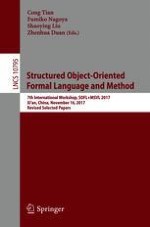2018 | Buch
Structured Object-Oriented Formal Language and Method
7th International Workshop, SOFL+MSVL 2017, Xi'an, China, November 16, 2017, Revised Selected Papers
herausgegeben von: Cong Tian, Fumiko Nagoya, Shaoying Liu, Zhenhua Duan
Verlag: Springer International Publishing
Buchreihe : Lecture Notes in Computer Science
